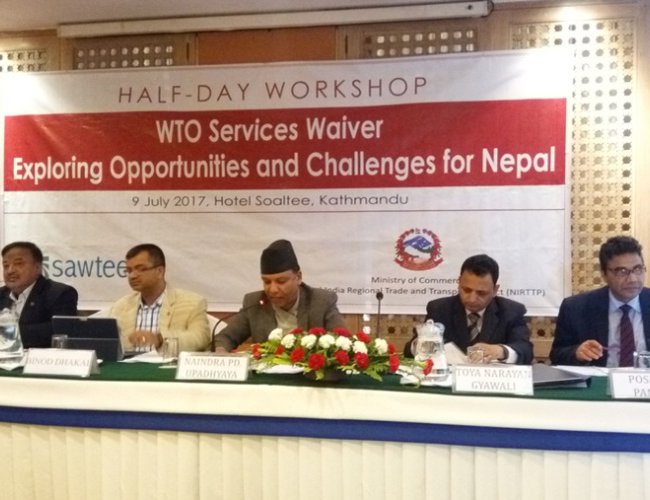
Lack of reliable supporting infrastructure has prevented Nepal’s information and communication technology (ICT) to take maximum advantage offered by the World Trade Organization’s Services Waiver provision accorded to the least-developed countries (LDCs), stakeholders said during a program organized here today.
Jointly organized by Ministry of Commerce and South Asia Watch on Trade, Economics and Environment (SAWTEE), a half-day workshop on WTO Services Waiver Exploring opportunities and challenges for Nepal searched a way to make Nepal’s ITC sector competitive.
It discussed the status of services sector in the Nepalese economy and its role in export promotion. The program also discussed the multilateral rules governing the services sector, including Services Waiver, and explored ways to benefit from the waiver provided to the LDCs by the developed and developing WTO members.
WTO members have adopted a decision to provide preferential treatment for services and services suppliers of the LDC members at the Bali Ministerial Conference which is generally known as the ‘Services Waiver’.
The preferences are subject to terms, limitations and conditions specified in the schedule of services commitments of the member countries. In response to the collective request of LDCs, the members of the WTO have submitted their services waiver commitment to the WTO Council for Trade in Services. So far 23 WTO members have submitted their Waiver commitments. The LDCs have 15 years from the day the Waiver is notified to the WTO to benefit from the provision.
Dr. Posh Raj Pandey, Executive Chairman of SAWTEE, during his presentation said that the status and trend of services sector in the Nepalese economy. He also explained the General Agreement on Trade in Services (GATS)under the WTO and the Services Waiver provision accorded to the LDCs. The presentation focused on various Waivers provided by the developed and developing WTO members within the 12 sectors and four different modes of services trade defined under the WTO regime.
Dr. Pandey highlighted the market access and national treatment provisions in the Waiver notifications of countries that may be possible destination of services export of Nepal, such as the European Union, China, United States, India, and Australia. He explained the Waivers provided in sectors such as Communication services, Construction services, Education services, Financial services and Tourism and travel related services.
Speaking during the program, Naindra Prasad Upadhyaya, Secretary at the Ministry of Commerce opined that there is a need for wider consultation with the private sector to understand the nature and direction of the services sector in Nepal to be better prepared to undertake negotiations in the bilateral, regional and multilateral levels.
Binod Dhakal, President, Federation of Computer Association of Nepal and Chair, ICT Development Committee, Federation of Nepalese Chambers of Commerce and Industry (FNCCI), commenting on the presentation, highlighted the difficulties faced by the ICT sector in Nepal. ICT sector is currently governed by the Ministry of Information and Communication and Ministry of Science and Technology. He also pointed out that there are numerous Business Process Outsourcing (BPO) companies operating from Nepal but they are not in the formal regulatory ambit to avoid regulatory hassles.
Toya Narayan Gyawali, Joint Secretary at Ministry of Commerce informed the floor that the government puts ICT on the forefront while designing its development strategy, and he also opined that the LDC Services Waiver can also be instrumental in achieving the Sustainable Development Goals in the long term. He also pointed out the lack of reliable data pertaining to service sector as one of the impediments while designing policies.
Steered by rapid growth in telecommunications, tourism and financial sectors, services sector is now the largest contributor to the GDP. The share of services in the GDP increased from 26 per cent in 1980 to 52 per cent in 2014/15 whereas agriculture and industry contributed 33 per cent and 15 per cent respectively. In 2015, services exports contributed to 63 per cent of the total exports and reached US$1.4 billion by value. The services exports are largely driven by travel and telecommunication (80 per cent in 2014), including an informal and rudimentary IT sector. Nepal’s export of labor services (Mode 4) in the form of labor migrants is specifically important as the workers’ remittances in 2014/15 contributed to 29 per cent of the GDP.
- TANAHU HYDROPOWER PROEJCT: A Significant Achievement
- Apr 15, 2024
- AMBASSADOR HANAN GODAR: Sharing Pain With A Nepali Family
- Mar 30, 2024
- VISIT OF KfW AND EIB TO NEPAL : Mission Matters
- Mar 25, 2024
- NEPAL BRITAIN SOCIETY: Pratima Pande's Leadership
- Mar 24, 2024
- NEPAL ARMY DAY: Time To Recall Glory
- Mar 15, 2024
















